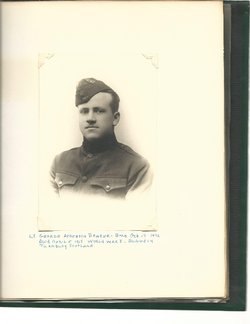Private First Class George Brader was an Aviation Cadet at the Turnberry Airfield Royal Flying Corps (RFC) Flight school (Turnberry School of Aerial Gunnery and Fighting). He was born in 1893 and was from Luzerne County, Pennsylvania and attended University of Pennsylvania Wharton Business School.. He learned Aviation as part of the Second Oxford Detachment. He became a pilot and served in England defending against Zeppelin attacks. Later he returned to the Turnberry Flight School where he was killed in a flight accident on April 5, 1918.
He is buried in the Doune Cemetery in Girvan, Scotland and is buried near fellow pilot in training, 1LT Squires. Both are remembered on the nearby Turnberry War Memorial (Turnberry School of Aerial Gunnery and Fighting Memorial).
From the Men of the Second Oxford Detachment Website:
George Atherton Brader
(Kingston, Pennsylvania, October 17, 1893 – Turnberry, Scotland, April 5, 1918).
The Braders were of German descent but had lived in Pennsylvania for several generations when Brader was born; his father was a “leading figure in real estate and insurance circles in Luzerne County.” After attending high school in Nanticoke, Pennsylvania, Brader studied at the nearby Wyoming Seminary business college. He graduated in 1916 from the University of Pennsylvania’s Wharton Extension School of Finance in Wilkes-Barre and worked for a time in his father’s Nanticoke insurance and real estate office.4 He was serving in the R.O.T.C. at the Madison Barracks in New York when he was accepted for aviation training in June of 1917. He attended Cornell ground school and graduated August 25, 1917.
Along with three quarters of his Cornell classmates, Brader was selected for training in Italy and thus sailed as a member of the 150 man “Italian” or “second Oxford detachment” to England on the Carmania. When they docked at Liverpool at the beginning of October they learned that they were not to go to Italy after all, but to train with the R.F.C. in England. They attended ground school (again) at Oxford. On November 3, 1917, Brader, along with most of the rest of the detachment, left for machine gun school at Harrowby Camp, near Grantham, in Lincolnshire. There Brader shared a hut with Wendell Ellison Borncamp, Ralf Andrews Crookston, Burr Watkins Leyson, Clark Brockway Nichol, Donald Swett Poler, Hilary Baker Rex, and Donald Andrew Wilson. Halfway through the course, when fifty of the cadets were posted to flying schools, Lloyd Ludwig moved into the hut as well. Borncamp, Brader, Ludwig, Poler, and Wilson, along with Melville Folsom Webber, would continue as a group in their training postings.
A man casually dressed squatting with a football in front of him.
On November 29, 1917, the Grantham cadets celebrated Thanksgiving in great style, with many of the men who were already at flying schools coming in to join them. Festivities included a football game between the “Unfits” and the “Hardly Ables.” Brader played with Ludwig on the winning “Unfits” team; Ludwig wrote in his diary that evening that “Mac [Maloney], Kerk, Brader and Hardin played great games.” Both Joseph Raymond Payden and Clayton Knight kept copies of a photo showing players, including Brader, from the winning team.
On December 3, according to a list compiled by second Oxford detachment member Fremont Cutler Foss, Brader, along with Borncamp, Ludwig, Poler, Webber, and Wilson, was posted to No. 51 Squadron at Marham in Norfolk. The squadron was tasked with defending this part of England from Zeppelin raids but, like other home defense squadrons, did its share of pilot instruction. Ludwig noted in his diary: “All the machines here are FE2B’s and as none of them are dual control machines; we will not be able to learn to fly here.”
Brader was apparently posted along with Ludwig and the other four cadets to Newmarket and No. 192 N.T. [Night Training] Squadron in mid-December 1917, where, again, according to Ludwig’s diary, flying opportunities were very limited. From there at the end of the month they were sent to Gosport, where, finally, they began serious training, initially on Avros, and then on S.E.5s. There were also opportunities for theater, dinners, and dances at nearby Portsmouth and Southsea. Ludwig records various such outings in January and February 1918 with “George” and “George and Don,” presumably referring to George Brader and Don Poler.
Brader’s very sketchy R.A.F. service record includes the annotation “Grad: C.F.S. 15-2-18,” indicating he’d flown the requisite number of hours solo, piloted a scout, and qualified to be recommended for his commission. Pershing’s cable forwarding the recommendation is dated March 16, 1918, and the confirming cable from Washington April 6, 1918.
Assuming Brader’s training continued to parallel that of Ludwig and Poler, he would have been at Castle Bromwich sometime in February. At some point he moved on to Turnberry in Scotland. There is a cryptic notation, “88 Sqdn,” on his R.A.F. service record; perhaps he was to be posted to this squadron, which left for France, equipped with Bristol Fighters, in April of 1918.15 However, Brader died at Turnberry on April 5, 1917. He was “carrying out gunnery practice” in S.E.5a C1762. He made an “outward spin at 150 feet [and the] mach[ine] spun into ground with engine on and caught fire on impact.” A court of inquiry determined that the crash was “due to an error of judgment in that he turned down wind with insufficient bank too near the ground, this error was probably due to his mistaking ground speed for air speed, the wind being fairly strong.”

PRIVATE CITIZENS SUPPORTING AMERICA'S HERITAGE
American
War Memorials Overseas, Inc.
War Memorials Overseas, Inc.
Brader George Atherton
Name:
George Atherton Brader
Rank:
Aviation Cadet
Serial Number:
Unit:
US Army Air Service
Date of Death:
1918-04-05
State:
Pennsylvania
Cemetery:
Doune Cemetery Girvan, South Ayrshire, Scotland
Plot:
West Div. Grave D.9
Row:
Grave:
Decoration:
Comments:
